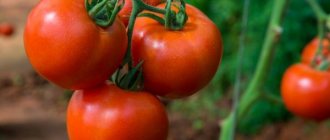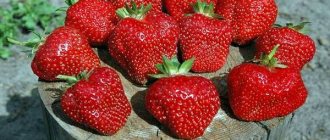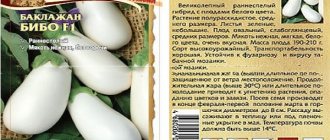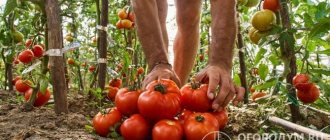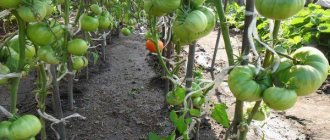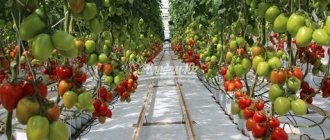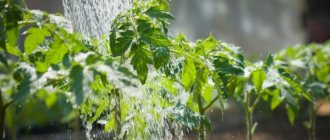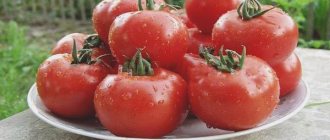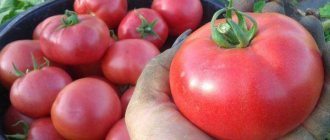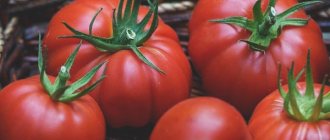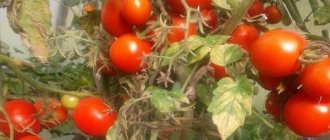Description
The mid-late Holiday strawberry bushes grow slightly spreading and medium in size. The leaves are large. The surface of the leaf blade is slightly wrinkled and covered with a pubescence. Leaf color is light green. Peduncles are low, powerful, located below the foliage level. The green sepals are not wide, located horizontally by the time the fruit ripens.
The first wave of the Holiday harvest is characterized by large berries with ridge-shaped tops. The average weight of one fruit is 32 g. Subsequent waves of the Holiday strawberry harvest bring smaller berries with a regular conical shape. The skin of the fruit is red and glossy. The pulp is light red, not loose, rich in juice and sugar. Small strawberry grains are located in yellowish achenes, not very deeply immersed inside the fruit.
The ripening of berries is consistent. The productivity of the Holiday variety per 1 acre reaches 150 kg. Strawberries have a dessert sweet and sour taste. The harvest can be transported and stored. Berries can be frozen, processed, or eaten fresh.
Important! The Holiday variety tolerates drought and frosty winters well and is rarely affected by diseases.
The video provides an overview of Holiday strawberries:
Advantages and disadvantages of the variety
| Positive features | Negative traits |
| The variety is rarely affected by diseases | Berries become smaller in subsequent harvest waves |
| Harmonious ripening of the crop | The variety is demanding on feeding |
| High yield | During drought, without watering, the taste of berries deteriorates. |
| Good winter hardiness and drought resistance | Productivity decreases when grown on infertile soil |
Drought resistance is considered a positive feature of the Holiday variety. However, strawberries really like abundant watering. The bush is able to survive in the heat with little moisture, but the quality of the berries and the quantity of the harvest will decrease.
Advantages and disadvantages
The variety implies a number of positive and negative aspects. It is important to familiarize yourself with them before boarding.
| pros | Minuses |
| High fertility - yield from 100 meters is about 100-150 kilograms | It is necessary to fertilize well |
| Juicy, sweet strawberry flavor | Flavor deteriorates when ripened during dry periods and without adequate watering. |
| Resistance to heat, frost, dry weather | Strawberries decrease in size after the first harvest |
| Resistance to diseases, insects | |
| Easy to transport, does not deteriorate |
Despite the small number of disadvantages and features, Holiday strawberries are extremely unpretentious in care and are becoming a frequent choice of gardeners with different experience. There is no need to be afraid that the bushes will freeze and will not bear fruit. They grow quickly and survive frosty winters, which is good for summer residents.
Reproduction methods
Traditionally, strawberries of the mid-late Holiday variety are propagated in three ways: by mustache, seeds or dividing the bush. Those who have no desire to do this work buy ready-made seedlings.
Usami
For the gardener, strawberry mustaches bring extra care associated with pruning, but for propagation these layerings are the best option. To propagate the Holiday variety, perform the following steps:
- With the last wave of the strawberry harvest, the growth of mustaches is activated. After picking the berries, weeds are removed from the garden beds and the rows are loosened.
- Strong strawberry tendrils with developed rosettes of leaves are straightened and laid on loose soil. A small yaku is squeezed into the ground by hand. The socket is placed in a recess, lightly covered with soil.
- By mid-September the rosettes will take root. You just need to remember to water them. The mustache is cut off from the mother strawberry bush and transplanted to another place.
The strongest rosettes are located on the tendrils first on the side of the bush. They are taken for propagation, and the rest are immediately cut off so that the juice is not drawn from the plant.
Dividing the bush
Holiday strawberries, like other varieties, can reproduce by dividing the bush. The method is considered traumatic for the plant, but allows the crop to be transplanted to another place in case of weak mustache formation. At the time of division, strawberry bushes of the mid-late variety should be 2–4 years old. For propagation, take plants with a well-developed root system.
In early spring or autumn, dig up a strawberry bush. The plant is divided into parts so that each horn has a rosette and long roots. After dividing, the strawberry seedlings are planted in a new bed.
Growing from seeds
The most labor-intensive way to propagate the variety is to grow Holiday strawberries from seeds. It is necessary to properly prepare the grains to obtain strong seedlings.
Seed production technique and stratification
Holiday strawberry seeds are better and easier to buy in the store. When picking yourself, you will need to select large overripe berries from the garden without damage. Using a knife, cut off the skin of the fruit along with the grains, lay it out on any sheet with a glossy surface, and place it in the sun. After 4–5 days, the moisture will evaporate and the strawberry seeds will dry out. All that remains is to collect them and then send them to be stored in a cool, dry place.
Before sowing, self-harvested Holiday strawberry grains are soaked, but it is better to stratify them. Each gardener has his own method of cold hardening seeds. The most common methods are as follows:
- I pour a layer of snow 1–2 cm thick onto fertile soil or peat tablets. Holiday strawberry seeds are laid on top. Place the container in the refrigerator for 3–4 days. The snow will melt, and the strawberry seeds will silt into the soil on their own.
- Place damp cotton wool inside a plastic bag and scatter strawberry seeds on top. The bag is tied and similarly sent to the refrigerator. After four days, grains of the mid-late strawberry variety Holiday are sown in containers with warm soil.
- The third method is based on mixing Holiday strawberry seeds with a small amount of wet peat or sand. Hardening similarly occurs in the refrigerator for two months. As the filler dries, it is moistened.
Stratification helps speed up seed germination of the Holiday strawberry variety up to 15 days. Without hardening, the grains will germinate in at least 30 days.
Attention! Purchased seeds of the Holiday strawberry variety go through all stages of processing in production. Before planting, the grains are soaked only in a growth stimulator.
Sowing time
For cold regions, the optimal time for sowing Holiday seeds is March - early April. Gardeners in the south begin sowing in mid-February.
Sowing in peat tablets
It is convenient to grow Holiday strawberry seedlings in peat tablets, since the procedure for planting them in the garden is then simplified. The process consists of the following steps:
- Peat washers are placed inside a plastic container with the planting holes facing up. Pour in a weak solution of potassium permanganate. After the peat tablets have swollen, the remaining water is drained, and the washers themselves are lightly squeezed out by hand.
- Holiday strawberry seeds are placed inside the planting holes. There is no need to fall asleep with anything. The grains will germinate in the light and take root.
- The container with Holiday crops is covered with film. Seed germination occurs at a temperature of +20°C. Periodically, the film is opened slightly to remove condensation.
Peat tablets need to be moistened. When peat dries out, it shrinks and can damage the strawberry root system. If mold appears on the washers, remove the plaque with a cotton swab and then treat it with Previkur.
Sowing in the soil
To grow Holiday seedlings in soil, you will need cups, boxes or flower pots. The container is disinfected and then filled with fertile soil. Gardeners use two sowing methods:
- Self-collected strawberry seeds are sown in the ground, deepened to about 5 mm. A 10 cm layer of snow is poured on top for hardening. The container is covered with film and placed in the refrigerator, where stratification occurs. After the snow clears, the crops are placed outside the window. Further, seedlings of the Holiday variety germinate at a temperature of 20–25°C. The film is opened daily for ventilation.
- Purchased factory-made seeds do not need to be hardened. Holiday grains are scattered on a damp cloth, laid out on a saucer, and placed on the window. To reduce evaporation, the grains are covered with film on top. When the strawberry seeds hatch, they are sown in containers with soil.
Holiday seedlings are grown at room temperature with artificial lighting.
Picking sprouts
With the appearance of 2–4 leaves on Holiday sprouts, the seedlings are planted in separate cups. There are two methods, depending on the density of seedlings:
- Transshipment. The simplest and most painless method for the plant. Seedlings of the Holiday variety should not grow densely so that a spatula can fit between them. The plant is removed from the ground and, together with the lump, transplanted into another container.
- Transfer. This is a rather complicated and painful picking method for the plant, used when sowing is very dense. Strawberry seedlings are removed from a container with a lump of earth and immersed in warm water. When the soil becomes limp, the Holiday strawberry seedlings are carefully removed so as not to damage the tangled roots. Weak plants are thrown away, and strong ones are planted in separate cups.
When picking, be sure to ensure that the root collar remains at ground level after replanting.
Why don't the seeds germinate?
The problem of non-germination of Holiday variety seeds often lies in non-compliance with the rules for growing seedlings. Gardeners ignore stratification, violate the temperature regime, collect grains incorrectly or overcook them in the sun.
Reviews from summer residents
Despite the fact that today a large amount of seedling material ready for planting is sold, including Holiday strawberries, many gardeners still try to get plants themselves, from seeds. According to reviews from gardeners, the seeds are characterized as difficult to germinate, so it is quite difficult to grow plants from them and it is best to use well-moistened peat tablets.
The “Holiday” variety of garden strawberries, according to gardeners, produces tasty, aromatic, large berries, of which there are many on each adult plant. Strawberries from American breeders are very unpretentious both in weather conditions and in care. The bushes resemble ordinary strawberries in appearance and grow very quickly. Flowering is abundant and constant. A large number of berries ripen at the same time, even on very young plants.
Strawberries of this variety are high-yielding and transportable. The yield with proper care and adherence to agricultural technology is at least 1–1.5 kg from each adult bush. Every year the yield decreases slightly, and the berries themselves become slightly smaller, but the appearance always remains marketable.
You may also be interested in an article that talks about the features of Lambada strawberries.
How to choose seedlings
To get a good harvest, you need to select healthy seedlings of the Holiday variety. The plant must have at least 3 adult leaves and a horn more than 7 mm thick. The color of the foliage is bright, juicy, the plates are without visible damage. A good strawberry seedling has an open root system that is at least 7 cm long. If the plant is in a cup, then the roots should entwine the entire lump of earth.
Site selection and soil preparation
The mid-late variety Holiday is planted in a sunny area. High ground is not the best place. During drought, strawberry roots become baked. The soil is prepared a couple of weeks before planting. The bed is dug up using a spade, adding 1 bucket of compost per 1 m2. If the soil is heavy, add sand when digging. In case of increased acidity, add chalk or another antioxidant.
Planting scheme
The Holiday variety is grown in rows. The seedlings are planted in holes at intervals of 30 cm. The row spacing is about 40 cm. After planting, the seedling is watered and shaded with an agrofibre shelter from the sun until it is completely rooted.
Growing the variety
The Holiday strawberry variety must be grown in accordance with the rules of agricultural technology. The bushes are regularly fertilized, mulched, and watered. Adult plants are capable of forming large and tall bushes; it is worth maintaining a distance between them of 40-45 centimeters.
When and where to plant
Sowing of seeds is carried out at the end of March and beginning of April in regions with a cold climate. In the south they sow from the second half of February. Seedlings are grown in containers with peat; you can use flower pots or boxes. When 3-4 leaves appear, plant the plant in open soil. Prepare the area for planting in advance.
The soil must have neutral acidity, be fertile, breathable, and free from moisture accumulation. The landing site should be located on a flat area with plenty of sun. It is not worth planting on a hill. Future bushes must be protected from the wind.
Selection of planting material
The easiest way to plant strawberries is with seedlings that are sold in gardening stores or at the market.
It is advisable to purchase seedlings from trusted sellers and pay attention to a number of nuances
Number of leaves. If the purchase occurs at the beginning of May, the seedlings should have 2-3 young leaves. Shade of leaves. It should be light green, the surface shiny, with a edge. A pale shade is a sign of fading horns. This disease cannot be treated - the plant will die. Leaf defect. If they are wrinkled, this is a symptom of tick infestation. Light or dark dots indicate fungal pathologies. The seedling must have 1 or more horns
It is important that they are not wrinkled and have a light green tint. You cannot buy seedlings with horn thickness less than 0.7 centimeters.
The thicker it is, the better it takes root and bears more fruit. Roots. Normally they are branched and at least 7 centimeters long. If the bush is sold in a peat container or tablet, the roots should be visible. To check the bush, it must be carefully lifted and removed.
If you take into account all the recommendations, you will be able to buy suitable seedlings and get a harvest the first time.
Landing technology
2 weeks before planting, you need to dig up the ground and fertilize it with compost in the appropriate proportions: 1 bucket per 1 square meter. To lighten clay soil, you can add river sand. To neutralize acidity, limestone is suitable. Dig holes for planting at a distance of 40 centimeters. After planting, water and shade with agronomic fiber until the bushes have fully developed roots.
Care
The Holiday variety requires traditional care, including watering, fertilizing, weeding and other work.
Care in spring
In early spring, after the snow has melted, the bed is cleared of leaves and remnants of winter shelter. The row spacing is loosened to a depth of 3 cm so as not to damage the roots. Immediately, plantings of the Holiday variety are fed with a solution of manure 1:3, chicken manure 1:10 or wood ash 100 g/m2 of the bed. After watering and weeding, the soil around the Holiday bushes is mulched with peat or sawdust.
Watering and mulching
The frequency of watering depends on the composition of the soil. With loose soil, the procedure becomes more frequent. Clay soil retains moisture longer. In such areas you can water after 1-2 days. Before flowering, strawberries can be watered by sprinkling once a week. With the appearance of flower stalks, water is supplied to the root. Set up drip irrigation. You can pour water from a hose along the rows, but there is a risk of washing out the roots. After watering, the soil is mulched with sawdust, straw or peat to retain moisture.
Advice! If heavy watering is stopped before harvest, Holiday strawberries will be sweeter and less watery.
Fertilizing by month
The Holiday variety needs not only organic feeding. In early spring, before flowering and after harvesting, mineral complexes containing nitrogen, phosphorus, and potassium are added. The time of application and the names of the drugs are shown in the table.
Preparing for winter
For the winter, the plantation with Holiday strawberries is covered with straw or hay. You can lay pine branches on top or simply cover it with pine needles. The bushes are first covered with peat. Organic matter will become additional insulation for the roots, as well as fertilizer.
Features of agricultural technology
Even a beginner can grow strawberries Andreas, since caring for them is not much different from other varieties of remontant garden strawberries. The main thing is to take into account agrotechnical standards.
First, you need to prepare a fertile bed by adding peat, humus, compost or mineral fertilizers.
Warning! Fresh manure cannot be applied to strawberries.
Secondly, when planting, there should be at least 30 cm between San Andreas strawberry bushes, and up to 40 cm between rows. It is better to plant seedlings in the fall. Plants are well watered and the soil is mulched.
Important! In the first year, flower stalks on the San Andreas variety should be cut off so that the plant gains strength for subsequent fruiting within 3-4 years. Then the plantings need to be updated
Then the plantings need to be updated.
Thirdly, as gardeners note in reviews, the San Andreas strawberry variety has a high need for watering and fertilizing. Does not tolerate the slightest drought. A drip irrigation system will help solve the problem of drying out beds.
Moreover, even a beginner does not have any special problems with its installation. The simplest drip irrigation can be organized using ordinary hoses, as shown in the photo below. What else is it convenient for? All strawberry crops frown upon wetting leaves, flowers and fruits with water. No matter how carefully gardeners use a watering can, strawberries cannot be avoided getting wet.
For the winter, the beds in the open ground are protected from frost. The degree of shelter will depend on climatic conditions.
Strawberry protection
To protect strawberries from diseases and pests, it is enough to plant other plants next to them.
For example, calendula will prevent infection with fungal diseases, and marigolds and marigolds will protect the roots from nematodes. Parsley planted between the rows will protect against slug invasion.
Experienced gardeners know that strawberries deplete the soil they grow in within four or five years. Therefore, after transplanting, you need to plant carrots and beans on the soil. In a year, this place may be occupied by pumpkin crops, and even later by nightshade crops. After this, the strawberries can safely return to their native garden and surprise with new high yields.
